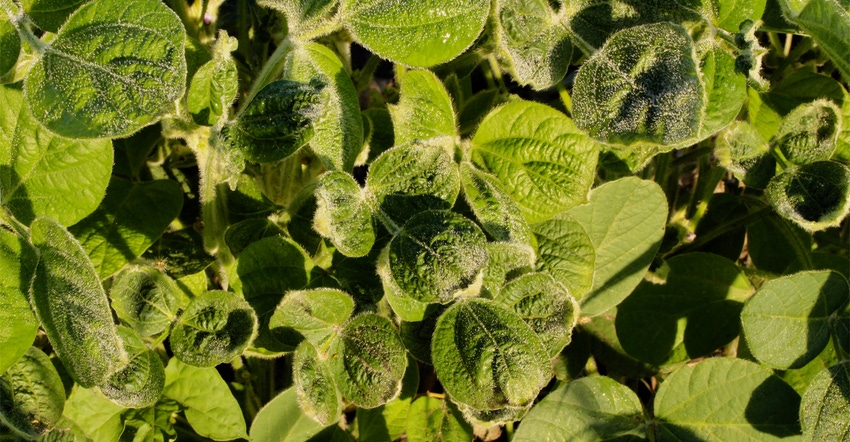April 21, 2017

It wasn’t a pretty picture as I walked the acreage — a lot of garden plants, trees and ornamentals weren’t looking very happy. The acreage was across the road from a pasture we had sprayed about 10 days earlier, and the owner was pretty sure we had drifted onto his property. With the massive amount of spraying my team did, I had the opportunity to experience more than a few contamination and drift calls; he might be right.
The variety of stunting, twisting and leaf cupping on his plants certainly matched up to what I had seen before with plant growth regulator (PGR) injury. On the other hand, we’d waited for a near-perfect day to spray the pasture, knowing that this beautiful acreage was across the road.
The breeze had been light the morning we sprayed. Weather records and spray sheets indicated it had been blowing away from his place all day. And just to be sure, we used drift-reduction additives as always. We both thought there was drift, but we couldn’t agree on where it might have come from. Given the amount of potential damage, to keep the process headed in the right direction, we agreed to call the Pesticide Bureau.
More drift damage calls
Every growing season, scenarios like this play out. But this year, with new PGR herbicides being marketed and applied, potential is huge for a surge in calls like this. While we won’t know what percentage of the new PGR-tolerant soybeans will actually have a PGR herbicide applied to them — even if it is a relatively small amount — it means a significant increase in the amount of PGRs applied across Iowa.
Another factor is a really good point that growers and dealers have shared with me for several years. That is, there has been a lot of media attention given to the PGR herbicides that go along with the new soybeans. With the heightened awareness of the increased use of these products, folks will be watching their PGR-sensitive plants closer than ever. While I have no doubt that as applicators we’ll follow the label and do everything we can to keep off-target issues to a minimum, odds are PGR injury symptoms are going to show up somewhere; they always do.
Seeing PGR injury symptoms on sensitive plants might make the conclusion of “off target injury” seem pretty cut and dried. But remember “innocent until proven guilty” — there are a lot of things that can mimic PGR injury. And if someone has plants that do have actual PGR injury, tracking down when and where it came from (and how significant the impact of the injury might be) presents a slew of challenges as well.
Questions on PGR injuries
Here are some common questions about PGR injury. We’ll focus primarily on dicamba, but many concepts are similar for other PGRs like 2,4-D.
• What does PGR injury to plants look like? Pictures are worth a thousand words, especially with herbicide injury. A quick web search of the brief descriptions here will help a lot. In soybeans, with low doses we often see leaf tip wrinkling and cupping (up or down). As the dose goes up, we can see puckering and what many call “strapping,” or leaf elongation. We can also see a darker green, sometimes almost bluish in more severely injured beans. Stunting and stem twisting can occur as well.
PRG symptoms show up well after the exposure occurs, so often when we get called about injured plants, the actual drift or contamination was a week or more prior. Injury can show up on a few new trifoliates, or can linger longer depending on the dose, timing, weather and other factors. While there is a lot of variability, in general, we see fruit, vegetable and landscape plants show similar symptoms as soybeans when they are exposed to PGRs.
• What’s the yield impact on soybeans? It depends on so many variables that making consistently accurate predictions is an exercise in futility, but there are some trends we discuss with clients when we look at these fields. If the plants quickly outgrow low levels of injury, especially during vegetative growth stages, typically we see little to no impact. On the other hand, the longer we see injury on plants, the more likely there could be yield loss. Injury that occurs in flowering and pod set stages can be the most problematic.
• What about other plants? This is even harder to answer than the soybean yield question. High-value crop plants like tomatoes, grapes, fruit trees and gardens tend to be very sensitive to PGRs. Many flowers, shrubs, trees and other ornamentals are sensitive as well. With some perennial plants, PGR exposure can have a ripple effect on growth and development for multiple seasons.
Combine this potential with other factors that can impact plant growth during and across seasons and you can see how complicated it can be to attempt to diagnose PGR injury. If you decide there is PGR injury, determining the short and sometimes long-term impact on plants takes a lot of work and is usually still open to a lot of interpretation.
Another perspective on what to look for
Speaking of what to look for, there are clues we can use as we scout an area of suspected PGR herbicide injury. Patterns in direction and variation in severity of symptoms in susceptible plants in the field, border areas, ditches and surrounding fields can help us determine if we are looking at PGR injury and where it may have come from. Sometimes patterns, or a lack of patterns, can help us determine if it is something that just looks like PGR injury.
Often if there is PGR drift, injury will be more obvious as we get closer to the source of the drift. Broadleaves in the field or border areas can offer clues; check to see if they show PGR symptoms and follow the clues toward potential sources.
Sprayer contamination can vary from the “V” pattern we see with PGRs being hung up in the plumbing to field-wide symptoms if there were PGR residues left in the main tank.
Volatility, a phenomenon sometimes associated with PGRs, often appears to flow downhill or into valleys. Off-target injury from inversions can behave in similar ways. On the other hand, off-target movement from volatility and inversions can be unpredictable and hard to track. In short, sometimes it takes a lot of detective work to try to figure out what happened.
Lesson learned?
So how did things work out with the acreage by that pasture we sprayed? It’s a long good news and bad news sort of thing, but here is the executive summary.
The Pesticide Bureau did a great job with the investigation, including taking plant samples to be analyzed by their lab. When the results came back to me about five months later, there were PGR herbicide residues in the samples. (The process is typically much faster now depending on seasonal demand; it could be a long season at the lab.) Much to my relief, they weren��’t the same products that we had sprayed on the pasture; the drift came from somewhere else.
Knowing that the property owner would have gotten the results in the mail, too, I gave him a call to discuss the news. After discussing the results, he agreed that the drift hadn’t come from us. When I asked if that meant he would drop his case against us to pursue other culprits, there was a short pause on the other end of the line. “Sure am glad your insurance company settled with me a couple months ago, thanks for calling.”
After I wired in a spare phone to replace the one I had just ripped off the wall, I called our company controller to find out what had happened. He walked me through the logic he and the adjuster had used; “sometimes the best course is to capitulate rather than to litigate.” I’m not sure what the lesson there was other than land line wires are really small and a pain to splice back together after you rip the phone off the wall a second time, but hopefully, you’ll have a trouble-free spray season and won’t have to worry about it; good luck and be safe!
McGrath is the On-Farm Research and Extension coordinator for the Iowa Soybean Research Center at Iowa State University.
About the Author(s)
You May Also Like






